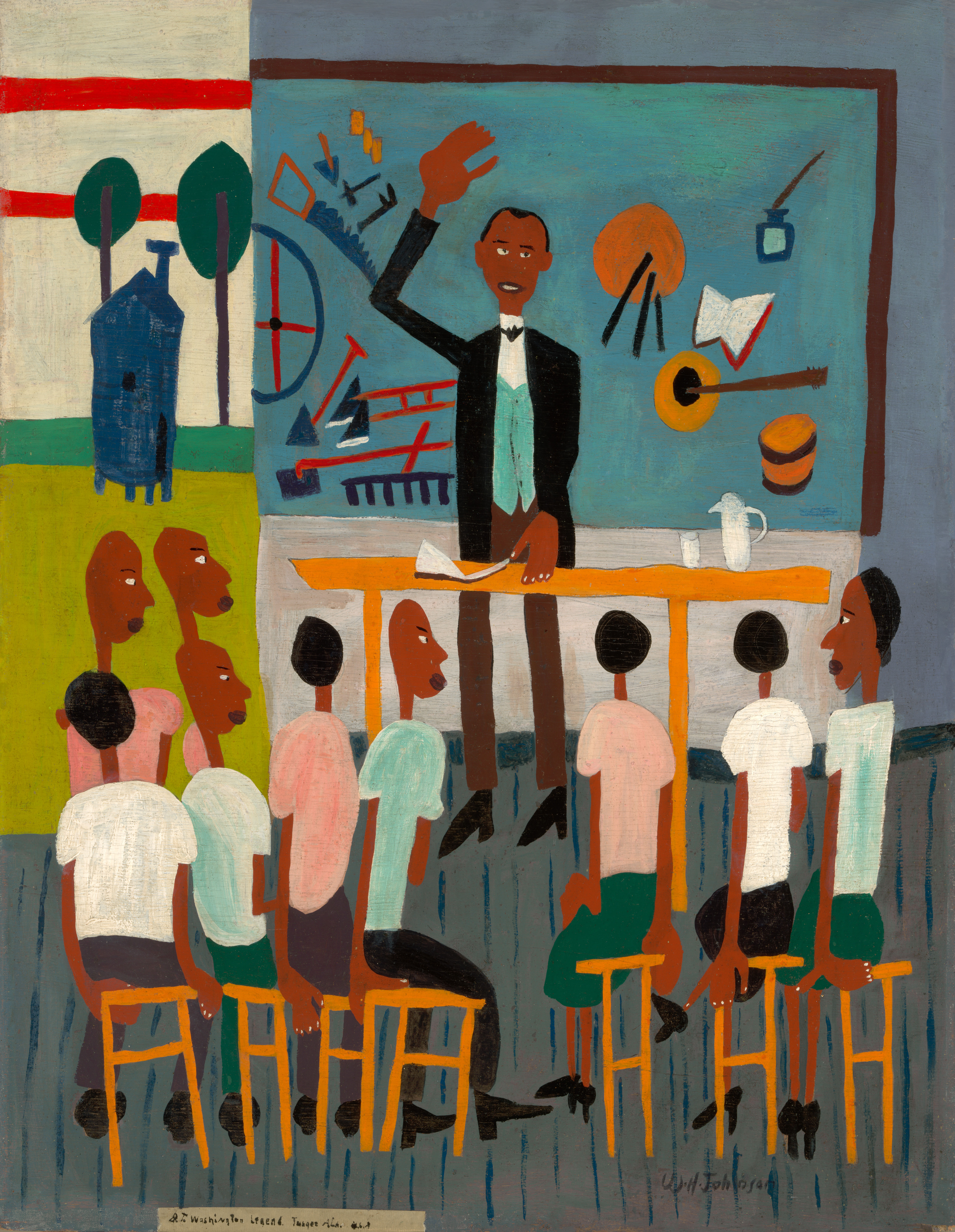Fighters for Freedom
William H. Johnson Picturing Justice
Harriet Tubman, George Washington Carver, Booker T. Washington, Frederick Douglass-–the names conjure greatness and hard-won freedoms for the individual and the cause of racial justice. Their lives, and the stories of two dozen more, come alive in William H. Johnson’s Fighters for Freedom.
Working from newspaper images, photographs published in Life and Ebony, and pictures from books in the Schomburg collection of the New York Public Library, Johnson created a pantheon of historic and contemporary leaders who fought for the freedom of the individual around the world. Through historic figures---Crispus Attucks, the first person killed in the American Revolution was one; Haitian rebel Toussaint L’Ouverture another---as well as scientists, educators, performers, and abolitionists, Johnson traced the stories and notable accomplishments of those who guided the country on a path toward social and political independence.
He was also keenly attuned to the contemporary moment. Events in the lives of Marian Anderson, Joe Louis, and Paul Robeson focused the national spotlight on the inequities suffered at home by these international giants. During World War II, Johnson depicted heads of state in Europe, Asia, and the United States meeting in far flung cities, and he painted portraits of Jawaharlal Nehru and Mahatma Gandhi who worked to throw off colonial rule abroad.
Rather than creating individual series featuring these fighters, as did Jacob Lawrence, a colleague who also taught at the Harlem Community Art Center, Johnson offered episodic vignettes that captured defining accomplishments, places, and sometimes multiple protagonists that told complete stories within a single image. Harriet Tubman, for example, shows the preeminent “conductor” of the Underground Railroad standing, rifle in hand, along a convergence of roads with the North Star bright above her head. At the lower right a bust-length portrait shows Tubman wrapped in the shawl presented to her by Queen Victoria. In Three Great Abolitionists, Abraham Lincoln, Frederick Douglass, and John Brown clasp hands in a yellow field with growing cotton, Gospel singers, a share cropper, and a lynched African American man. Marian Anderson is surrounded by flags and buildings representing cities around the world where she performed. In a small vignette at the center right, she shakes hands with Eleanor Roosevelt, who had arranged for Anderson to perform on the national mall, standing in front of the sculpture of Abraham Lincoln after the Daughters of the American Revolution cancelled her performance at Constitution Hall because she was black. Boxers frames Joe Louis between the cabin where he grew up and the army barracks where he served before beginning his reign as the world heavyweight champion from 1937 to 1949.
Through the Fighters for Freedom, William H. Johnson celebrated defining moments that linked past and present individuals who, over the course of some two hundred years, had changed the lives of countless individuals across the globe.
William H. Johnson (1901-1970), the man who painted the Fighters for Freedom, had struggled, too. As a seventeen year old he left the Jim Crow life of Florence, South Carolina and headed for New York to become an artist. He worked as a laborer, saving money and building the painter’s skills that would earn him admission to the National Academy of Design. By the time he completed the course of study in 1926, he had won the Hallgarten Prize, the Canon Prize, and five more awards from the distinguished institution. Then, like so many other aspiring artists of his generation, he headed for Paris. There and in the south of France he painted expressionist landscapes and light-struck buildings that marked him as an up-and-coming modernist.
On his return to the States, Jonson showed his work and won additional prizes. He spent time in New York and painted family and friends in Florence. In Washington, DC, he visited Harlem Renaissance writer and Howard University professor Alain Locke, who acted as something of an agent for Johnson. While staying at Locke’s home, he met poet Langston Hughes and presented Hughes with a painting.
In 1930 Johnson returned to Europe, married Danish weaver and ceramist Holcha Krake. For the next eight years the couple lived and traveled throughout Denmark and Norway. They visited Tunisia, where he painted mosques and markets; in the Netherlands he studied the work of Vincent van Gogh.
In Scandinavia Johnson had lived in a white European world. On his return to New York in late 1938, he embraced his blackness and put the brilliant expressionistic landscapes and portraits from the Scandinavian years behind him to focus on African American life at home. For the next seven years he painted share croppers in the south, hipsters in New York, jitterbug dancers, black soldiers training for war, religious subjects drawn from Negro spirituals, and, his last series, the Fighters for Freedom.
By the mid-1940s, Johnson’s health had begun to deteriorate. Devastated by the recent death of his wife, he returned to Denmark, hoping to regain happier times. But his mental state was increasingly unstable. He was returned to the United States and hospitalized at Central Islip State Hospital on Long Island, where he remained, unable to paint, for the last two decades of his life.
Johnson showed the Fighters for Freedom only twice. Once at the 135th Street Branch of the New York Public Library during “National Negro History Week” in 1946 and again in Copenhagen in 1947, under the title “For Freedom and the U.N.” Although individual panels appeared in exhibitions from time to time, the group as a whole has not been seen in the United States for almost seventy-five years.
William H. Johnson, Commodore Peary and Henson at the North Pole, ca. 1945, oil on paperboard, Gift of the
Harmon Foundation, 1983.95.54




